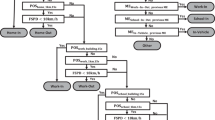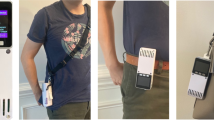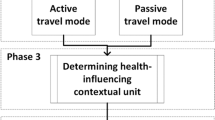Abstract
A critical aspect of air pollution exposure assessment is the estimation of the time spent by individuals in various microenvironments (ME). Accounting for the time spent in different ME with different pollutant concentrations can reduce exposure misclassifications, while failure to do so can add uncertainty and bias to risk estimates. In this study, a classification model, called MicroTrac, was developed to estimate time of day and duration spent in eight ME (indoors and outdoors at home, work, school; inside vehicles; other locations) from global positioning system (GPS) data and geocoded building boundaries. Based on a panel study, MicroTrac estimates were compared with 24-h diary data from nine participants, with corresponding GPS data and building boundaries of home, school, and work. MicroTrac correctly classified the ME for 99.5% of the daily time spent by the participants. The capability of MicroTrac could help to reduce the time–location uncertainty in air pollution exposure models and exposure metrics for individuals in health studies.
This is a preview of subscription content, access via your institution
Access options
Subscribe to this journal
Receive 6 print issues and online access
$259.00 per year
only $43.17 per issue
Buy this article
- Purchase on Springer Link
- Instant access to full article PDF
Prices may be subject to local taxes which are calculated during checkout


Similar content being viewed by others
References
Integrated Science Assessment for Particulate Matter (Final Report); EPA/600/R-08/139F; United States Environmental Protection Agency: Washington, DC, USA 2009.
HEI panel on the health effects of traffic-related air pollution: a critical review of the literature on emissions, exposure, and health effects. HEI Special Report 17. Health Effects Institute, Boston, MA, USA, 2010.
National Research Council. Epidemiology and Air Pollution. The National Academies Press: Washington, DC, USA. 1985.
Vette A, Burke J, Norris G, Landis M, Batterman S, Breen M et alCommunity Action Against Asthma Steering Committee. The near-road exposures and effects of urban air pollutants study (NEXUS): study design and methods. Sci Total Environ 2013; 448: 38–47.
Breen MS, Breen M, Williams RW, Schultz BD . Predicting residential air exchange rates from questionnaires and meteorology: model evaluation in central North Carolina. Environ Sci Technol 2010; 44: 9349–9356.
United States Environmental Protection Agency. Exposure Model for Individuals (EMI). Available at http://www.epa.gov/heasd/emi.
Wallace L, Willams R . Use of personal-indoor-outdoor sulfur concentrations to estimate the infiltration factor and outdoor exposure factor for individual homes and persons. Environ Sci Technol 2005; 39: 1707–1714.
Burke JM, Zufall MJ, Ozkaynak H . A population exposure model for particulate matter: case study results for PM2.5 in Philadelphia, PA. J Expo Anal Environ Epidemiol 2001; 11: 470–489.
United States Environmental Protection Agency Total Risk Integrated Methodology (TRIM)—Air Pollutants Exposure Model Documentation (TRIM.Expo/APEX, Version 4.4) Volume I: User’s Guide, EPA-452/B-12-001a; Office of Air Quality Planning and Standards, US EPA: Research Triangle Park, NC. Available at http://www.epa.gov/ttn/fera/human_apex.html.
United States Environmental Protection Agency Total Risk Integrated Methodology (TRIM)—Air Pollutants Exposure Model Documentation (TRIM.Expo/APEX, Version 4.4) Volume II: Technical Support Document, EPA-452/B-12-001b; Office of Air Quality Planning and Standards, US EPA, Research Triangle Park, NC. Available at http://www.epa.gov/ttn/fera/human_apex.html.
McCurdy T, Glen G, Smith L, Lakkadi Y . The national exposure research laboratory’s Consolidated Human Activity Database. J Expo Anal Environ Epidemiol 2000; 10: 566–578.
Williams R, Suggs J, Rea A, Leovic K, Vette A, Croghan C et al. The Research Triangle Park particulate matter panel study: PM mass concentration relationships. Atmos Environ 2003; 37: 5349–5363.
Williams R, Rea A, Vette A, Croghan C, Whitaker D, Stevens C et al. The design and field implementation of the Detroit Exposure and Aerosol Research Study. J Expo Sci Environ Epidemiol 2009; 19: 643–659.
Chaix B, Meline J, Duncan S, Merrien C, Karusisi N, Perchoux C et al. GPS tracking in neighborhood and health studies: a step forward for environmental exposure assessment, a step backward for causal inference? Health Place 2013; 21: 46–51.
Beekhuizen J, Kromhout H, Huss A, Vermeulen R . Performance of GPS-devices for environmental exposure assessment. J Expo Sci Environ Epidemiol 2013; 23: 498–505.
Misra P, Burke BP, Pratt MM . GPS performance in navigation, Proceedings of the IEEE. 1999; 87: 65–85.
GE L, Han S, Rizos C . Multipath mitigation of continuous GPS measurements using an adaptive filter. GPS Solutions 2000; 4: 19–30.
Nuckols JR, Ward MH, Jarup L . Using geographic information systems for exposure assessment in environmental epidemiology studies. Environ Health Perspect 2004; 11: 1007–1015.
National Research Council. Exposure Science in the 21st Century: a Vision and a Strategy. The National Academies Press: Washington, DC, USA. 2012.
Klepeis NE, Nelson WC, Ott WR, Robinson JP, Tsang AM, Switzer P et al. The national human activity pattern survey (NHAPS): a resource for assessing exposure to environmental pollutants. J Expo Anal Environ Epidemiol 2001; 11: 231–252.
Breen MS, Breen M, Butts K, Chen L, Saidel GM, Wilson DL . MRI-guided thermal ablation therapy: model and parameter estimates to predict cell death from MR thermometry images. Ann Biomed Eng 2007; 35: 1391–1403.
Adams C, Riggs P, Volckens J . Development of a method for personal, spatiotemporal exposure assessment. J Environ Monit 2009; 11: 1331–1339.
Elgethun K, Yost M, Fitzpatrick C, Nyerges T, Fenske R . Comparison of global positioning system (GPS) tracking and parent-report diaries to characterize children’s time-location patterns. J Expo Sci Environ Epidemiol 2007; 17: 196–206.
Wu J, Jiang C, Houston D, Baker D, Delfino R . Automated time activity classification based on global positioning system (GPS) tracking data. Environ Health 2011; 10: 101.
Kim T, Lee K, Yang W, Yu S . A new analytical method for the classification of time-location data obtained from the global positioning system (GPS). J Environ Monit 2012; 14: 2270–2274.
Tandon P, Saelens B, Zhou C, Kerr J, Christakis D . Indoor versus outdoor time in preschoolers at child care. Am J Prev Med 2013; 1: 85–88.
Landrigan P, Trasande L, Thorpe L, Gwynn C, Lioy P, D’Alton M et al. The National Children’s Study: a 21-year prospective study of 100000 american children. Pediatrics 2006; 118: 2173–2186.
Chen D, Zhang L, Li J, Liu R . Urban building roof segmentation from airborne lidar point clouds. Int J Remote Sensing 2012; 33: 6497–6515.
Acknowledgements
We thank Jennifer Richmond-Bryant and Karen Wesson for review comments and helpful suggestions. MB was supported by the North Carolina State University/Environmental Protection Agency Cooperative Training Program in Environmental Sciences Research, Training Agreement CT833235-01-0 with North Carolina State University. YC was supported by the Oak Ridge Institute for Science and Education (ORISE)/Environmental Protection Agency Research Participation Training Program (Interagency Agreement DW-89-92298301-0). Procedures involving humans were conducted in accordance with US EPA Order 1000.17 Change A1 (Policy and Procedures on Protection of Human Research Subjects). These procedures were reviewed and approved by the US EPA Human Subjects Research Review Official. Although this manuscript was reviewed by the US Environmental Protection Agency and approved for publication, it may not necessarily reflect official Agency policy. Mention of trade names or commercial products does not constitute endorsement or recommendation for use.
Author information
Authors and Affiliations
Corresponding author
Additional information
Supplementary Information accompanies the paper on the Journal of Exposure Science and Environmental Epidemiology website
Supplementary information
Rights and permissions
About this article
Cite this article
Breen, M., Long, T., Schultz, B. et al. GPS-based microenvironment tracker (MicroTrac) model to estimate time–location of individuals for air pollution exposure assessments: Model evaluation in central North Carolina. J Expo Sci Environ Epidemiol 24, 412–420 (2014). https://doi.org/10.1038/jes.2014.13
Received:
Accepted:
Published:
Issue Date:
DOI: https://doi.org/10.1038/jes.2014.13
Keywords
This article is cited by
-
Microenvironment Tracker (MicroTrac) model to estimate time-location of individuals for air pollution exposure assessments: model evaluation using smartphone data
Journal of Exposure Science & Environmental Epidemiology (2023)
-
Automated classification of time-activity-location patterns for improved estimation of personal exposure to air pollution
Environmental Health (2022)
-
The MEDEA childhood asthma study design for mitigation of desert dust health effects: implementation of novel methods for assessment of air pollution exposure and lessons learned
BMC Pediatrics (2021)
-
Use of wearable sensors to assess compliance of asthmatic children in response to lockdown measures for the COVID-19 epidemic
Scientific Reports (2021)
-
Dynamic classification of personal microenvironments using a suite of wearable, low-cost sensors
Journal of Exposure Science & Environmental Epidemiology (2020)



